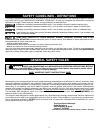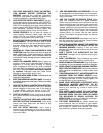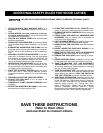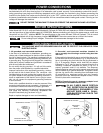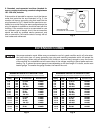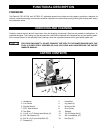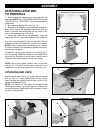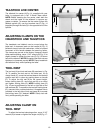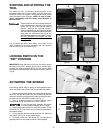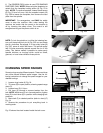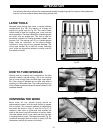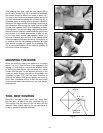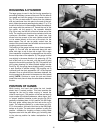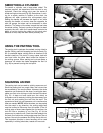
8
Fig. 7
Fig. 8
A
B
B
A
C
Fig. 6
The hole in the pedestal (C) Fig.6 can be used to fill the
pedestal with sand or concrete to provide more ballast.
NOTE: If sand is used, pour a small amount of concrete
or similar material in the pedestal to prevent sand leak-
age through the seams.
ATTACHING LATHE BED
TO PEDESTALS
Fig. 5
1. Remove tailstock, headstock, and tool rest from the
lathe bed. NOTE: See “ADJUSTING HEADSTOCK AND
TAILSTOCK” and “TOOL REST” for removal/installation
instructions.
2. Set pedestals exactly 58” apart (Fig. 5).
3. Because of the weight, use an assistant to place the
lathe bed on top of the pedestals. Make sure that the
holes in the lathe bed are aligned with the holes in the
tops of the pedestals (Fig. 6) A and B.
4. Attach the lathe bed to the pedestals, using the
twelve 3/8-16 x 3/4” Hex Head bolts and lock washers.
In addition to showing the location of the bolt (A) Fig. 7
also shows that additional ballast can be added in the
lathe bed (B). Steel bars, or other heavy material can be
inserted into the lathe bed to provide more weight.
NOTE: Use a good quality furniture wax on the lathe
bed (C) Fig. 7 to allow for smoother movement of the
headstock, tool rest, and tailstock and to prevent rust.
ATTACHING END CAPS
Attach the end caps, (A) Fig. 8, to both ends of the lathe
with 1/4-20 x 1/2” button head screws (A) Fig. 9 (out-
side) the lathe bed through the end caps to the 1/4-20
flange nut (inside) (B) Fig. 8 .
NOTE: The flange nut can easily be dropped while
attaching the endcap. To prevent loss of the flange nut,
use a small piece of cardboard or other material to cover
the hole in the pedestal.
A
B
Fig. 9
A
B
B
C
58”
ASSEMBLY




